The content of the article
The cuticle has a protective function, it does not allow germs and foreign bodies to penetrate into the nail plate. The cuticle is a dead skin, which, with a strong growth, spoils the appearance of the hands and makes it difficult to properly conduct a manicure procedure. When untimely removal, it begins to grow into the nails, slows their growth, contribute to the appearance of burrs, which are often accompanied by painful sensations.
Preparation for the cuticle removal procedure
First you need to soften the skin to the procedure was effective. For these purposes, hot broths are used.
Trays for softening the cuticle
- In 250 ml. warm water, add 30 grams. starch, 15 gr. food salt or soda. Stir until complete dissolution of the granules, lower the fingers into the composition, wait a quarter of an hour.
- 100 ml.microwave olive or corn oil in a microwave to an acceptable temperature. Lower your fingers, perform the procedure for 10 minutes. Then remove the oil with a paper napkin.
- Squeeze the juice from 1 lemon, combine it with 80 ml. vegetable oil, add 50 ml. hot water to get a mixture of comfortable temperature. Lower the fingers, do the bath for 15 minutes.
- 60 gr. baking soda pour 300 ml. warm water, drip 6 ml. iodine, spend the procedure 10 minutes. The bath will not only soften the cuticle, but also strengthen the nail plate.
- Heat up in a microwave 230 ml. beer, add to it 12 drops of rosemary ether and calendula ether. Dip your fingers in the composition, hold for 20 minutes.
- Preheat 240 ml. milk and add 60 grams. flaxseed bran, leave for 10 minutes, then put your fingers in the container. Wait 20 minutes.
- Pour boiling water 20 gr. Chamomile flowers, 20 g. birch bark and 30 gr. plantain, insist 40 minutes. After the expiration date, warm the bath to a comfortable temperature, add 30 ml. juice aloe vera and proceed to the procedure. The duration of exposure ranges from 15 to 25 minutes.
After your fingers have softened well, rinse them with warm water and wipe dry with a towel.Now you need to rub into the cuticle and the nail plate, first vitamin A in ampoules, then vitamin E, all these products are sold by the pharmacy by the piece. Next, cover your fingers or skin with a fully nourishing cream (preferably for children).
Cuticle removal procedure
At home, two technologies are used: classical and European. Consider them step by step.
Classical technique
Required tools:
- nail forceps;
- vitamins A and E in ampoules;
- scapula or cuticle stylus.
Important!
Be careful during the procedure, the method is extremely dangerous for an inexperienced person. Proceed to remove the cuticle only after it is fully softened with baths. It is important to understand that it is necessary to remove only the horny part, without touching the living tissue. The dead epithelium separates almost immediately after softening; difficulties should not arise if all recommendations are followed. Disinfect the forceps and scissors with alcohol, vodka, peroxide, or chlorhexidine to prevent bacteria from entering the nail plate cavity.
- Smear the cuticle with a special compound or use natural oil. This is necessary so that it remains soft throughout the removal procedure.
- Now you need to push the cuticle to the base of the nail, so that its edges are clearly visible. You can do this with the help of a nail stylus or orange sticks.
- Grab one finger with your other hand, stretch the cuticle to bulge the edge. Take the nail clippers and cut the cuticle first from one side, moving to the middle, then from the second. You can not cut it in one direction, otherwise you touch the living areas with the other side of the forceps.
- Now remove all the burrs without touching the skin around them. Your movements should be careful not to create tumors.
- Wipe the cuticle with a peroxide or chlorhexidine solution, paying particular attention to the sheared burrs. Reapply vitamins A and E to the skin, massage the living tissues of the cuticle in a massaging motion and leave it absorbed.
The procedure for removing the cuticle in the classic way is complete!
European methodology
The safest way to remove the cuticle at home.
Depending on the temperature and destination, there are three types of European methods: wet, dry and hot.
The wet method involves the use of trays, as in the classical method of removing the cuticle.
The dry method is to soften the cornified areas with natural oils or special means for the cuticle. It is important to understand that such drugs may be an allergic reaction. Test in advance on a small area of skin.
The hot method involves the excessive steaming of the skin with the baths, which may be necessary in the case of a strongly overgrown cuticle on the base of the plate.
Necessary materials:
- cuticle remover;
- cotton buds;
- vitamins A and E in ampoules;
- cuticle remover that slows its growth;
- stylus or orange cuticle sticks.
- Give the nails the desired shape and length, then proceed to the direct softening of the cuticle. Choose 1 of 3 ways depending on the state of your fingers.
- Move the cuticle with an orange stick or stylus, lifting it up.
- Apply to the cotton swab cuticle remover in small quantities. Distribute it evenly on dead and steamed areas, trying not to affect healthy skin. Wait a specified time on the package, as a rule, it is 10-20 minutes depending on the manufacturer.
- Take a dry cotton swab and walk on the softened areas, which are removed remover. The cuticle should soften by this time and turn into a kind of jelly, which is easily removed. If it was not possible to remove everything with a wand, use the stylus. Clean the cuticle with the nail plate, moving upwards, not towards the free edge of the nail.
- At the end of the manipulation, wipe your fingers with a paper towel, treat your fingers with hydrogen peroxide. Massage vitamins A and E into the skin around the nails and leave for 40 minutes until completely absorbed. After that, cover the cuticle with a special agent that slows down its growth.
Congratulations, you have successfully removed the cuticle by the European method!
Practical recommendations
- Cuticle remover can be purchased at the pharmacy.The tool refers to drugs for nail care. Pay attention to the series "Smart enamel", the company produces a remover with a convenient dispenser, due to which the composition is squeezed out in the right quantities. Apply the composition in such a way that the cuticle is covered with 1 mm. in height.
- Wash dishes and do other household chores with rubber gloves only. Get baby talc without fragrances, put it in gloves so that your hands do not sweat.
- Do not allow the growth of the cuticle on the plate. Otherwise, it will grow into the nail, due to which it will be difficult to remove it later. Perform a classical or European removal 1 time in 10 days.
- Wear a moisturizer in a purse. Always lubricate the skin when it is too dry, especially for summer care. In winter, lubricate your hands with anti-frost cream half an hour before going out, always wear warm mittens.
- If you often relax on the beach, try to avoid prolonged contact with the sand. Rinse your hands with running water after you buy in salt water springs. This also applies to visiting the pool, chlorinated water dries the skin.
- Every day, lubricate the cuticle with essential oil. Prefer jojoba, orange, tea and rosewood, ginseng and geranium. Once a week, make a bath for nails and cuticles from natural oil (olive, vegetable, burdock, corn, sea buckthorn, castor).
To get rid of the cuticle at home, you must first prepare the fingers. Do not be lazy to mix the composition for the baths, they are also useful for the nail plate. It is important to understand that the classical technology is quite dangerous when improperly carried out, so for the first time it is recommended to resort to the European method.
Video: how to cut the cuticle in one strip

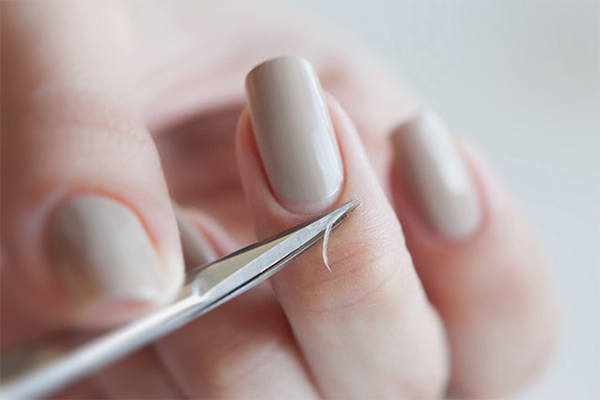
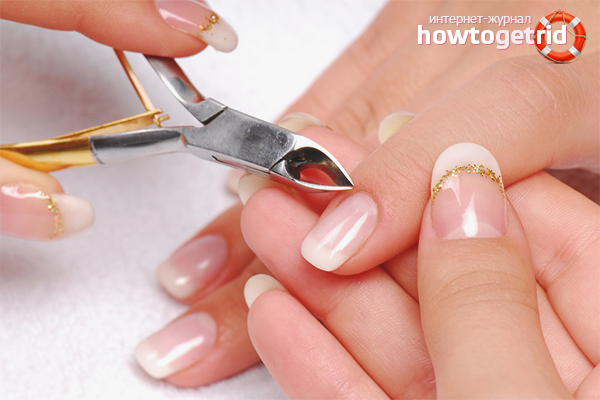
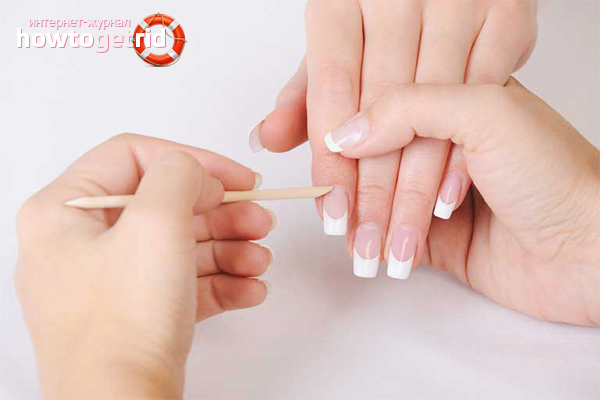

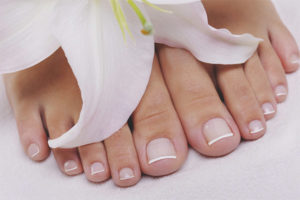
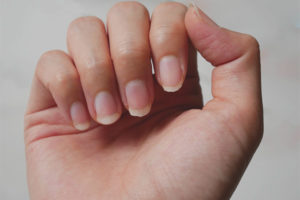
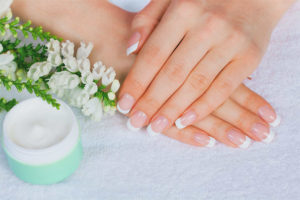
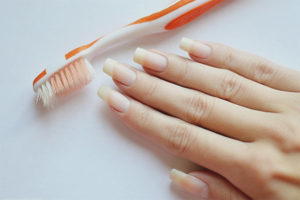
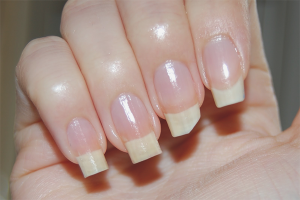

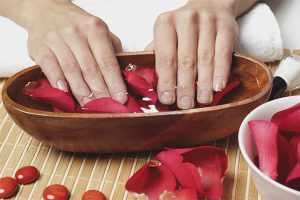
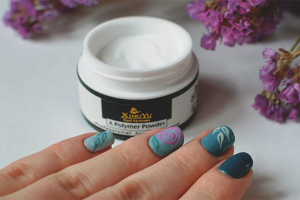
To send